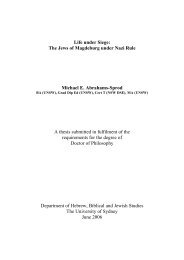Epimechus Dietz (Coleoptera: Curculionidae: Anthonomini)
Epimechus Dietz (Coleoptera: Curculionidae: Anthonomini)
Epimechus Dietz (Coleoptera: Curculionidae: Anthonomini)
Create successful ePaper yourself
Turn your PDF publications into a flip-book with our unique Google optimized e-Paper software.
INSECTA MUNDI, Vol. 15, No.2, June, 2001<br />
glabrous except for dense, imbricated scales at<br />
extreme base; distal portion glabrous. Antenna:<br />
funiculus with 6 segments. Prothorax: pronotum<br />
with dense, rounded, narrowly to broadly imbricated,<br />
cretaceous scales; slightly narrower, infuscate<br />
scales present dorsolaterally and on pleuron. Elytra:<br />
narrow, parallel sided, rounded apically in dorsal<br />
view; flattened on disc, rounded posteriorly in lateral<br />
view; striae narrow, punctures with minute,<br />
inconspicuous setae; inter striae with rounded,<br />
slightly to broadly imbricated, recumbent scales;<br />
pallid cretaceous scales dense basally on sutural<br />
inter striae and interstria 6 and on longer median<br />
and posteromedian portions of inters tria 4, variously<br />
interspersed elsewhere among slightly to<br />
distinctly narrower, slightly to deeply infuscate<br />
scales; sutural interstriae slightly prominent. Pygidium:<br />
evenly convex. Abdomen: sterna 1-4 with<br />
dense, imbricated, pallid scales laterally, with sparser,<br />
narrower scales medially; sternum 5 convex,<br />
with elongate, setiform scales medially. Legs (Fig.<br />
32): profemur; protibia with inner margin prominent<br />
in basal 112, concave in apical 112; protibial<br />
uncus long, slender, slightly curved; metatibia of<br />
male straight on outer margin, slightly prominent<br />
in basal 2/3 on inner margin; metatibial mucro<br />
long, extended nearly perpendicular to long axis of<br />
tibia in lateral view, strongly curved; metatibia of<br />
female with inner margin slightly prominent in<br />
basal 2/3, slightly concave in apical 113, outer margin<br />
straight; metatibial mucro stout, conical, acute,<br />
oblique. Genitalia (Fig. 45): median lobe of aedeagus<br />
narrow, constricted and narrowed behind slight<br />
apical expansion in dorsal view; endophallus with<br />
one slender, slightly irregular sclerite.<br />
Specimens examined. <strong>Epimechus</strong> hesperius is<br />
known from the type series, a fairly large number<br />
of specimens indicating that the species is widespread<br />
throughout much of the western United<br />
States and northern Mexico.<br />
Plant associations. Label data indicate that some<br />
adults of E. hesperius were collected on the following<br />
Asteraceae: "Artemesia", Haplopappus gracilis<br />
(Nutt.) Gray (as "Aplopappus gracilis"),<br />
"Chrysothamnus", Gutierrezia californica (DC).<br />
T&G, G. sarothrae (Pursh) Britt. & Rusby, and<br />
"Xanthocephalus". The "Bred Chrysothamnus"<br />
record indicates that this plant is a true host.<br />
Remarks. Otherwise resembling E. nevadicus and<br />
E. combustus in size and body form, E. hesperius is<br />
115<br />
distinguished by the distinctive form of the long,<br />
slender, slightly curved apical mucro on the male<br />
metatibia (Fig. 44). In addition, E. hesperius is<br />
distinguished from these and other species of <strong>Epimechus</strong><br />
by the slender, slightly, evenly curved<br />
rostrum (Fig. 23), by the long, slender endophallic<br />
transfer apparatus (Fig. 45), and by the strong<br />
subapical constriction of the median lobe of the<br />
aedeagus (Fig. 45). The species name, based on a<br />
Greek adjective meaning "western", reflects the<br />
distribution of this widespread species<br />
Acknow ledgments<br />
Thanks are extended to the individuals and<br />
institutions listed in the Materials and Methods<br />
section for loans of specimens.<br />
References Cited<br />
Blatchley, W. S. 1916. [<strong>Epimechus</strong> nivosus sp.<br />
nov., p. 277] In: W. S. Blatchley and C. W. Leng,<br />
Rhynchophora or weevils of North Eastern<br />
America. Nature Publishing Company, Indianapolis,<br />
Indiana. 682 pp.<br />
Boldt, P. E., and T. O. Robbins. 1992. Life<br />
history of <strong>Epimechus</strong> canoides Fall (<strong>Coleoptera</strong>:<br />
<strong>Curculionidae</strong>) on seepwillow, Baccharis salicifolia<br />
(R.&P.) Pers. (Asteraceae). Proceedings<br />
of the Entomological Society of Washington<br />
94(3):309-313.<br />
Boldt, P. E., and T. O. Robbins. 1994. Phytophagous<br />
insect faunas of Baccharis salicina, B.<br />
pteroniodes, and B. bigelovii (Asteraceae) in<br />
the southwestern United States and northern<br />
Mexico. Environmental Entomology 23(1):47-<br />
57.<br />
Burke, H. R. 1968. Pupae of the weevil tribe<br />
Anthonominae (<strong>Coleoptera</strong>: <strong>Curculionidae</strong>).<br />
Texas Agricultural Experiment Station Technical<br />
Monograph 5, 92 pp.<br />
Burke, H. R. 1971. New synonymy in North American<br />
Anthonomus. Journal of the New York<br />
Entomological Society 44(1):46-50.<br />
Burke, H. R. 1975. Nomenclatural changes in<br />
North AmericanAnthonomus (<strong>Coleoptera</strong>: <strong>Curculionidae</strong>).<br />
Entomological News 86(3-4):57-62.<br />
Clark, W. E., and H. R. Burke. 2001. Revision of<br />
the weevil genera Magdalinops <strong>Dietz</strong> and Chelonychus<br />
<strong>Dietz</strong> (<strong>Coleoptera</strong>: <strong>Curculionidae</strong>, <strong>Anthonomini</strong>).<br />
Coleopterists Bulletin. In Press.<br />
<strong>Dietz</strong>, W. G. 1891. Revision of the genera and<br />
species of <strong>Anthonomini</strong> inhabiting North Amer-
















